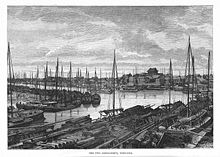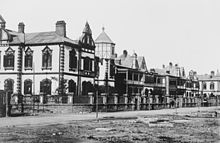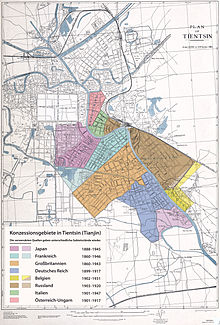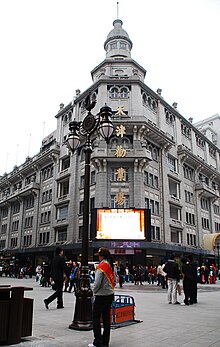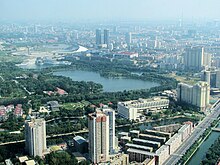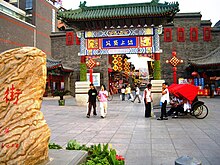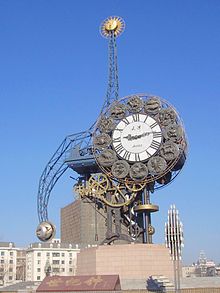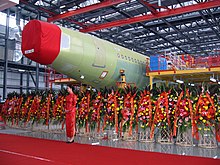Tianjin
| Tiānjīn Shì 天津市 Tianjin |
||
|---|---|---|
 Clockwise from top: Night panorama of Hai He shore - Tianjin Jinwan Plaza and Jin Tower , St. Joseph Church / Xikai Church in Heping , Tianjin city center, Tianjin Central Station , the ferris wheel - The Tianjin Eye |
||
|
|
||
| Coordinates | 39 ° 8 ' N , 117 ° 11' E | |
| Basic data | ||
| Country | People's Republic of China | |
| region | North china | |
| Government immediate city | Tianjin | |
| ISO 3166-2 | CN-TJ | |
| status | Government immediate city | |
| structure |
15 districts, 1 new district, 118 large communities, 106 street districts, 19 communities, 1 nationality community |
|
| height | 5 m | |
| surface | 11,946.9 km² | |
| Residents | 14,131,500 (2012) ( 7. ) | |
| density | 1,182.9 Ew. / km² | |
| Post Code | 300000-301900 | |
| Telephone code | (+86) 22 | |
| Time zone | China Standard Time (CST) UTC +8 | |
| License Plate |
津 A, B, C, D, F, G, H, J, K, L, M 津 E (taxis) |
|
| Website | www.tj.gov.cn | |
| politics | ||
| mayor |
Zhang Guoqing 张国清 |
|
Tianjin ( Chinese 天津市 , Pinyin Tiānjīn shì , W.-G. T'ien-chin - "literally Heaven's ford city", obsolete after Post Tientsin , Stange Tientsin ) is an important port city in the People's Republic of China . The entire administrative area of the city has an area of 11,943 square kilometers. Tianjin is one of the four cities in China that is directly subordinate to the government, i.e. it is directly subordinate to the central government in Beijing and has the same status as a province.
The entire administrative area of Tianjin has 12.94 million inhabitants (status: 2010 census) . Of these, 9.5 million are registered residents with permanent residence ( 戶口 / 户口 , hùkǒu ) and 1.0 million temporary residents ( 流動 人口 / 流动 人口 , liúdòng rénkǒu ) with a temporary residence permit ( 暫住 證 / 暂住 证 , zànzhùzhèng ). If you take the core city with its high density of buildings and closed local form as a basis, 3.8 million people live in Tianjin as their main residence. The metropolitan area has 6.4 million inhabitants, including suburbs. (Status: 2007)
The city is the industrial center, transport hub and cultural center of the region with universities, colleges, museums and monuments. The administrative area of Tianjin is not a contiguous urban area, but - with its dominant rural settlement structure - would be more comparable to a small province. Historically, Tianjin was the capital of the former Zhili Province .
geography
Geographical location
The city is located in the north of the country, southeast of Beijing, five meters above sea level, at the confluence of the Hai He and the Imperial Canal . It is bordered by the government city of Beijing and Hebei Province .
The administrative city area has an area of 11,943 square kilometers. This corresponds roughly to the surface area of Upper Austria and is slightly smaller than Schleswig-Holstein . Of this, 167.8 km² (1.4%) belong to the core city (high building density and closed locality) and 11,775.2 km² (98.6%) to suburbs and areas with a rural settlement structure.
It is 120 kilometers from Tianjin's city center to Beijing. Bohai Bay is located 50 kilometers east of Tianjin. The Hai He River flows through the city to Bohai Bay.
The entire administrative area of the city of Tianjin, which is directly under the government, has a north-south extension of 186 kilometers and an east-west extension of 101 kilometers. The largest cities are: Tianjin 3,755,249 residents, Tanggu 564,498 residents, Hangu 227,358 residents, Gangdong 141,741 residents, Yangliuqing 77,768 residents, Xianshuigu 75,366 residents and Yangcun 64,908 residents. (As of January 1, 2007)
geology

The North China Plain (Great Plain), in which Tianjin lies, is geologically a collapse field that was later filled in by the delta formations of the North China Rivers. It consists of alluvial loess and sands that have been brought in from the rivers from the western mountainous countries. The plain is a continuation of the loess land.
Also climatically - hot, humid summers and dry, cold winters with dust storms - and plant-geographically - parkland with steppe-like lines - it is similar to the neighboring Loessberg countries. The North China Plain is a huge alluvial cone that the Huang He , the richest muddy river on earth, has raised over the course of many millennia and whose foothills reach the Yellow Sea north and south of the Shandong Peninsula . The area is exposed to strong tectonic stresses that repeatedly lead to earthquakes. The cause is the slow shift of the Indian continental plate northwards into the Eurasian continental plate. The speed of plate tectonics averages around four centimeters per year.
On July 28, 1976 , the worst earthquake of the 20th century occurred in Tangshan , 120 kilometers east of Tianjin (see the 1976 Tangshan earthquake ). It had a magnitude of 8.2 on the Richter scale . The official figure of the government of the People's Republic of China about the number of deaths is 242,419, but some estimates give a number of up to 800,000 deaths, 25,000 of them in Tianjin, and officially the strength is only given as 7.8. The quake caused severe damage in Tianjin and other cities in the region.
City structure
The administrative area of the city is divided into 15 city districts and a "new" city district.
The core city is divided into six districts:
- Heping ( 和平 区 , Hépíng Qū )
- Hexi ( 河西 区 Héxī Qū),
- Hebei ( 河北 区 , Héběi Qū )
- Nankai ( 南开 区 , Nánkāi Qū )
- Hedong ( 河东 区 , Hédōng Qū )
- Hongqiao ( 红桥 区 , Hóngqiáo Qū )
Four further districts are located in the vicinity of the core city:
- Jinnan ( 津南 区 , Jīnnán Qū )
- Dongli ( 东丽 区 , Dōnglì Qū )
- Xiqing ( 西 青 区 , Xīqīng Qū )
- Beichen ( 北辰 区 , Běichén Qū )
Five boroughs and the new Binhai borough are in the rural areas outside the core city:
- Binhai ( 滨海 新区 , Bīnhaǐ Xīnqū )
- Baodi ( 宝坻 区 , Bǎodǐ Qū ) - circle until 2001
- Wuqing ( 武清 区 , Wǔqīng Qū ) - circle until 2000
- Jizhou ( 蓟州 区 , Jìzhōu Qū ) - Ji County until 2016
- Jinghai ( 静海 区 , Jìnghǎi Qū ) - circle until 2015
- Ninghe ( 宁河 区 , Nínghé Qū ) - circle until 2015
See also List of Tianjin Boroughs
climate
Although Tianjin is only about 50 kilometers from the coast, due to its location in the west wind belt it has a temperate, continental climate , i.e. warm, humid summers and cold, dry winters. The annual rainfall is 560.2 millimeters on average, of which about 61 percent falls in the months of July and August.
The annual average temperature is 13.0 ° C. The warmest month is July with a mean daily high of 30.7 ° C and a mean nighttime low of 22.7 ° C. The coldest month in the Tianjin area is January with a mean daily high of 1.6 ° C and a mean nighttime low temperature of −7.7 ° C.
| Tianjin | ||||||||||||||||||||||||||||||||||||||||||||||||
|---|---|---|---|---|---|---|---|---|---|---|---|---|---|---|---|---|---|---|---|---|---|---|---|---|---|---|---|---|---|---|---|---|---|---|---|---|---|---|---|---|---|---|---|---|---|---|---|---|
| Climate diagram | ||||||||||||||||||||||||||||||||||||||||||||||||
| ||||||||||||||||||||||||||||||||||||||||||||||||
|
Average monthly temperatures and rainfall for Tianjin
Source:
|
|||||||||||||||||||||||||||||||||||||||||||||||||||||||||||||||||||||||||||||||||||||||||||||||||||||||||
In winter temperatures down to −20 degrees Celsius and an icy wind blowing from the plains of Inner Mongolia . Summer (June to August) is humid and hot with temperatures of up to 35 degrees Celsius, the short spring (April and May) is dry but windy. In autumn (September and October) the weather is dry and mild.
When the wind comes from the north it can get very cold in winter and sandstorms are frequent in spring. The highest temperature ever recorded was officially measured on July 4, 1972 at 39.7 ° C, the lowest on February 22, 1966 at −22.9 ° C.
history
Origin and further development
The history of the place from fishing village to modern trading metropolis goes back many centuries and is strongly linked to the history of Beijing . From the 11th to the 14th centuries, Tianjin was a small seaport that was of great importance as a grain store for the imperial court. Later, when originally independent empires were subjugated in southern China, the city was a port of passage for tributes and supplies from those empires to the capital. During the Yuan Dynasty in the 13th century, the Imperial Canal leading through Tianjin was finally completed or extended to Dadu (Beijing).
The city was named Tianjin by the Emperor Zhudi during the early years of the Ming Dynasty (1368–1644). At that time it received its primacy as a port for Beijing and a heavily fortified garrison town . Later, under the Qing Dynasty (1644–1911), it became a flourishing trading center (especially for sea salt ).
Foreign concessions
In the 19th century, the seafaring powers from the west took notice of the city. As a result of the defeat of China in the First Opium War , Great Britain forced the opening of five southern Chinese port cities for its trade through the Treaty of Nanking in 1842 (see Unequal Treaties ). Under the pretext - Chinese officials had arrested the British flagged Lorcha Arrow on October 8, 1856 - the United Kingdom declared war on China again. In this so-called Second Opium War , also known as the “ Arrow War ”, which France joined on the British side for comparable commercial reasons, the European gunboats and warfare proved to be superior. (see gunboat policy ) With the Treaty of Tianjin , signed on June 27, 1858, the victorious Europeans received the right to set up further concessions on the Chinese mainland . In return, the withdrawal of the English from Tianjin ( historical legend Tientsin) and the evacuation of the fortress Dagu , 60 kilometers southeast of the city, were planned. China subsequently refused to implement the treaty. The British then opened the second phase of the Second Opium War in June 1859 with another attack on Dagukou . It was only after the campaign in 1860, during which an invading army led by Lord Elgin laid the Old Summer Palace in Beijing to rubble and ashes, that Prince Gong confirmed the terms of the contract on behalf of Emperor Xianfeng, who had fled to Manchuria . In the so-called Beijing Convention of October 18, 1860, they were supplemented by further points, in particular the opening of the port of Tianjin itself, further reparations payments and assignments of territory to Great Britain and Russia .
On this basis, Great Britain and France (as in the 1840s in Shanghai) first established two concession areas in Tianjin, southeast of the walled city, from which northern China could be opened up for international trade. Due to the growing importance of the city as an important trade and communication center (as "Shanghai of the North") not far from Beijing, further colonial powers (Russia, Japan , German Empire , Austria-Hungary , Belgium and Italy ) followed by means of diplomatic powers until 1895/1900 negotiated follow-up contracts (see Unequal Contracts ) and created separate concessions along the Hai He . These foreign enclaves - built in the respective national architectural style - had their own infrastructure and administration. The concessions shaped the development of Tianjin into a modern city, but also symbolized the quasi-colonial penetration of China. One of the main streets that ran through these European districts (today's "Jiefang Beilu", 解放 北路 - "literally the north of the Liberation Route") had names in sections that represented the respective rule: "Rue de la France", "Victoria Road" and “Wilhelmstrasse” (or after 1919 “Woodrow Wilson Road”). In 1900 Tianjin was the scene of bitter fighting in the context of the Boxer Rebellion , as a result of which the geopolitical importance of the city grew with increased foreign garrisons . Some of the concessions continued to exist de jure until 1943.
As part of the 2008 Olympic Games in Beijing, parts of the former Italian concession areas were revitalized as tourist attractions. A similar project for the Austrian concession area is in preparation.
Riots and Japanese occupation

Tensions between the local population and the privileged foreigners erupted. a. in the events of Tianjin on June 21, 1870, the so-called Tianjin massacre ( 天津 教案 , Tiānjīn jiào'àn , historical spelling Tientsin massacre), when an angry Chinese crowd left the French orphanage of Notre-Dame-des-Victoires ( 望 海樓 教堂 / 望海楼 教堂 - "Wanghailou Church"). The reason was rumors of Chinese orphans who had been bought or abducted there, and even of cases of cannibalism by the European nuns. Despite efforts by Chinese officials to reassure the people, the situation escalated, as a result of which the French consul, nuns, priests, other foreigners and Chinese Christians were killed. It is assumed that there were around 60 victims in total. Twenty Chinese were then beheaded and the prefect banished from the city.
Although or rather because Tianjin (historically Tientsin) was in fact a protectorate of European foreign powers, the city rose to become the second largest trade and communication center in China after Shanghai .
As the center of the secret resistance against the Europeans, the city was the scene of bitter fighting during the Boxer Rebellion in the summer of 1900 . From here the expedition corps formed by soldiers from eight nations (a total of 2066 soldiers) set out to relieve the legation district in Beijing, which was besieged by insurgents and regular Imperial Chinese troops, on June 10, 1900, but did not get through and even got into Tianjin in the meantime the defensive. With the landing of larger contingents of foreign troops (mainly British-Indian , Russian , Japanese and American units ) and their arrival in Tianjin on July 14, 1900, the connection to the coast was restored. The concessions saw the deployment of the now significantly reinforced multinational army (approx. 20,000 soldiers), which reached Beijing on August 13, 1900 and was able to free the trapped foreigners. Larger parts of the old town, including Tianjin's city walls, were destroyed during the fighting but soon rebuilt in a European style. Finally, the foreigners removed the walls and the old Chinese quarter in order to have a better view of the residents.
A prominent resident in Tianjin at the time of the Boxer War was Herbert Hoover , the later (31st) President of the USA , who was then working as a mining engineer in China. After he and his family had survived the week-long bombardment of foreign concessions by the "boxers", he was able to be useful to the following US marines as a local expert . For Hoover, Tianjin was a “ universal city - like a world in miniature with all its nationalities, architectural styles and kitchens”.
As a result of the Boxer Rebellion and its suppression, the geopolitical importance of the city grew due to the increased number of foreign garrisons.
From 1900 to 1909 the city was administered by an international commission in which those powers were represented that had branches in Tianjin: Russia , Great Britain , France , Belgium , Japan , Italy , Austria-Hungary and the German Empire .
In 1906, the first tram went into operation in Tianjin .
After he was expelled from the Forbidden City and placed under the care of the Japanese legation, Aisin Gioro Pu Yi , the last emperor of the Qing Dynasty , moved to Tianjin on February 23, 1925. Here he resided in a manorial villa in the Japanese concession until 1932 and took an active part in the social life of the cosmopolitan port city.
In 1927, Tianjin was given the status of an independent city at the provincial level ( 直轄市 / 直辖市 - " Government Immediate City ").
With the beginning of the Second Sino-Japanese War as a result of the so-called incident at the Marco Polo Bridge (Lugouqiao) on July 7, 1937 near Beijing (then Peiping), Japanese troops, who had already occupied Manchuria in 1931 and already large parts of northern China, advanced controlled (see Manchuria Crisis ), across the Great Wall at Shanhaiguan to the south. On July 29, 1937, Tianjin - especially Nankai University, which is adjacent to the Japanese concession as an active center of "anti-Japanese agitation" by the nationally conscious Chinese student body - was bombed by Japanese aircraft. The few poorly managed Chinese units could hardly resist the overwhelming strength of the Japanese army , so that the next day the city was taken almost without a fight and was under Japanese occupation until the end of the war. The sovereign rights of the other colonial powers, with which Japan was not (yet) at war, were initially respected, so that the foreign concessions continued to exist. However, with the Japanese blockade of the British concession in the summer of 1939, it soon became apparent that it could not be held militarily. Even before Japan entered the war against the USA and Great Britain, their garrisons withdrew from Tianjin in 1940.
During this time the expansion of the Tianjin-Xingang seaport falls.
The Japanese occupation lasted until August 15, 1945, when American forces marched into the city after the surrender of Japan and the end of World War II . In December 1946, the rape of Chinese women in Tianjin by American soldiers sparked protests in the city that culminated in a large demonstration on January 1, 1947. The US troops then withdrew from Tianjin in June 1947.
Communist reign
Communist troops took Tianjin on January 15, 1949 after a battle lasting 29 hours during the civil war with the Kuomintang - troops one. After the communist takeover, Tianjin initially remained an independent city district at the provincial level in China. In 1958, Tianjin became the capital of Hebei Province and in 1967 was given the status of a government immediate city.
According to official figures, 23,938 people died in the Tangshan earthquake in 1976 in Tianjin and the city suffered severe damage. Since the implementation of the economic reforms decided by the Chinese government in 1978, Tianjin's economy has shown high, stable growth to this day, which has led to rapidly growing prosperity for large parts of the population.
The biggest problems the city is facing today because of the failed modern urban planning policy are increasing immigration, air pollution caused by outdated factories and excessive traffic, which contributes to poor air quality and brings the city to the brink of traffic collapse. But many social problems are also experiencing a renaissance, which it was thought that the communists would have eliminated forever after 1949. Unemployment, drug abuse and prostitution are all growing rapidly.
On August 12, 2015, at the port in Tianjin (in Binhai ), severe explosions occurred in a warehouse for hazardous materials . 173 people died and 797 were injured.
Population development
While the population of Tianjin has doubled since the 1950s, it has remained relatively constant since the early 1990s - also due to the introduction of the one-child policy . In the core city (high density of buildings and closed local form) live 3.8 million people with main residence (2007). The population density is 22,379 inhabitants per square kilometer.
The entire administrative area of the government immediate city has 10.5 million inhabitants (2007). Of these, 9.5 million are registered residents with permanent residence ( 戶口 / 户口 , hùkǒu ) and 1.0 million temporary residents ( 流動 人口 / 流动 人口 , liúdòng rénkǒu ) with a temporary residence permit ( 暫住 證 / 暂住 证 , zànzhùzhèng ). The population density is 879 inhabitants per square kilometer. The urbanization rate for the entire administrative area of Tianjin is given as 72 percent.
If you want to stay in the city for more than three days, you have to report to the Office for Public Security and be registered there. The applicant then receives a temporary residence permit for three months, which must be extended after the deadline. A certificate from the home town must be presented to the office confirming that the person is registered there.
Of the 9,848,731 residents of Tianjin as recorded in the 2000 census, 97.29% were Han Chinese, 1.75% Muslim Hui Chinese , 0.57% Manchu , 0.12% Mongolian, and 0, 11% Koreans . Of the 56 officially recognized nationalities of China, only four are not represented among the residents of Tianjin.
The following overview shows the population of the core city (excluding the suburbs). Registered residents with main residence in Tianjin are listed.
|
|
Development of the living situation
The supply of living space is still precarious, even if, according to official information from the city government, the living space per capita has tripled since 1957. The communist city government had by no means been idle, since the early 1950s the living conditions in the city districts had been improved to an inadequate standard and many new residential areas were built. In China, it is expected that up to 350 million more rural residents will flow into the urban conurbations over the next few decades.
For a number of years there has been a noticeable tendency to build large new housing estates in connection with landscape parks, golf courses and artificially created lakeshore areas. These buildings are mostly above the normal standard, are designed for a high-earning middle class and are hardly affordable for the average earner. A special project is the construction of an ecologically sustainable large housing estate. Around 24 kilometers south of the city center, around a 7 kilometer long and 3 kilometer wide artificial lake, attempts are being made to counter the monotony of a dormitory city serially equipped with high-rise buildings. Around a third of the several square kilometer areas east of the suburb of Jinghai are to be supplied with renewable energy, otherwise an infrastructure suitable for everyday use and workplaces close to the settlement are to be provided. The Chinese government has declared the project to be a reference project for future urbanizations. The first apartments will be ready for occupancy in early 2013, and everything should be ready by 2020.
The living situation of the approximately one million residents with limited residence permits is significantly worse than that of residents with their main residence. Numerous migrants , mostly former farmers from the rural regions of China, live on construction sites, in simple company dormitories or rent a room from farmers on the outskirts of the city. A large proportion of the temporary residents live on the outskirts, because there is more space for self-built huts.
politics
City government
Huang Xingguo was the mayor of Tianjin from 2007 to 2016 and the acting party secretary of the Chinese Communist Party . On September 10, 2016, he was released from both positions on charges of corruption. Party secretary has been Li Hongzhong since September 13th . On September 14, 2016, Wang Dongfeng was appointed executive mayor.
The city government is subordinate to the governments of 15 city districts and three counties. The city districts are in turn divided into street quarters , partly also into municipalities and large municipalities . The districts, on the other hand, are made up of municipalities and large municipalities, only in Ji District , which has developed a small urban center, there is a street district. At the lower end of Tianjin's administrative pyramid are the so-called communities of residents ( 社區 / 社区 ) in the urban areas , which are administered by the residents' committees ( 居民委員會 / 居民委员会 , jūmín wěiyuánhùi ) and in the rural regions the villages ( 村 ), which are managed by Village committees ( 村民 委員會 / 村民 委员会 , cūnmín wěiyuánhùi ) are administered.
Town twinning
Tianjin has partnerships with the following cities:
| city | country | since |
|---|---|---|
| Kobe |
|
June 24, 1973 |
| Philadelphia |
|
February 10, 1980 |
| Melbourne |
|
May 5th 1980 |
| Yokkaichi |
|
October 28, 1980 |
| Sarajevo |
|
May 28, 1981 |
| Groningen |
|
September 12, 1985 |
| Chiba |
|
May 7, 1986 |
| Izmir |
|
September 23, 1991 |
| Ulaanbaatar |
|
September 27, 1992 |
| Kharkiv |
|
June 14, 1993 |
| Jönköning |
|
September 23, 1993 |
| Incheon |
|
7th December 1993 |
| Łódź |
|
October 1, 1994 |
| Hải Phong |
|
January 8, 1999 |
| Hakodate |
|
2001 |
Regional partnerships
Tianjin has partnerships with the following regions:
| region | country | since |
|---|---|---|
| Nord-Pas-de-Calais |
|
October 10, 1984 |
| Lombardy |
|
May 9, 1985 |
| Plovdiv Oblast |
|
October 15, 1989 |
| Abidjan district |
|
September 26, 1992 |
| Saarland |
|
September 27, 1994 |
| State of Rio de Janeiro |
|
April 18, 1995 |
| Orange County |
|
August 7, 1997 |
| State of Amazonas |
|
October 21, 1997 |
Culture and sights
theatre
Tianjin is home to numerous theaters, operas and concert halls. The People's Art Theater opened in 1951 and shows contemporary and classical plays. The Opera and Dance Drama Theater opened in 1959 and has classical opera and dance performances in its repertoire. The Tianjin Peking Opera Theater was opened in 1995 and mainly shows classical Peking operas.
Beijing operas are also performed in the Guangdong Guild House , a theater with seating for 700 to 800 people. At the beginning of the Qing dynasty (1644–1911), the house was mainly made of wood. Each of the three main girders of the theater were made from a tree at least 40 to 50 meters long. The stage is open on three sides, so that the spectators sitting in the side rows also have an excellent view. Other theaters in Tianjin include the Grand Opera Theater , the Song and Dance Theater, and the State Puppet Theater .
Museums
The Art Museum, a magnificent old building, houses a collection of paintings, dragons, Chinese New Year prints, and clay figures (niren), the manufacture of which became a popular craft in the 19th century . Among its most prominent exponents was the cartoonist Zhang, who recreated opera stars and other celebrities, some of whom can be seen in the museum.
The new Museum for Science and Technology has a large number of exhibits that clearly illustrate scientific findings. There are also exhibitions on acupuncture and physiology, as well as models of the Chinese “Long March Rockets”. In the section of the museum devoted to gravity, visitors can explore ball bearings, and the optics department displays distorted images of Mao and Marx on display for demonstration purposes. Further up in the house is a 360-degree projection room where you can watch a film about astronomy .
To the southwest of the center, the huge Zhou Enlai Memorial pays tribute to the city's most famous son. On the northern edge of Shuishang Park is the bunker, the interior of which houses wax figures, the aircraft and Zhou Enlai's limousine , as well as some information in English about his achievements. The memorial to Zhou Enlai, who attended school here between 1913 and 1917, was established in 1978.
Buildings
In Tianjin, the streets with their buildings from the 19th and early 20th centuries are particularly interesting, mostly European style and side by side with the concrete and glass buildings of today's affluent China. The old town used to be strictly divided according to national affiliation and each part has retained a piece of its character. To the northwest of the main train station, on the west side of Hai He, was the old Chinese quarter.
To the east, on the north bank of the river, lay the Austrian, Italian, Russian and Belgian concessions , the old buildings of which were largely destroyed. The chateaux of the French concession, which today make up the inner city area south of the river, and the mansions of the British east of it are unmistakable. Further east, also on the south side of the river, there are examples of strict German architecture in an otherwise inconspicuous area.
One of the main attractions is the Temple of Great Compassion (Da Bei Yuan), the oldest part of which was built in 1669 under Emperor Kangxi . The facility, which was expanded in 1940, was rebuilt according to old plans after the 1976 earthquake. Small antique Buddhist statuettes made of wood and bronze are exhibited in a room to the west of the complex.
Notre Dame des Victoires ("Wanghailou Church") is located on the north bank of the river . It was built in 1904 and is already the third on this site - the first building was destroyed a year after its construction in the 1870 massacre, the second burned down in 1900 during the Boxer Rebellion. The unadorned cathedral with its dark stones and its strict formality of its lines stands in stark contrast to the Catholic Church further south.
Located directly at the confluence of the Hai He and the Imperial Canal , the Palace of the Sky Goddess ( Tianhou Gong ) was founded in 1326 during the time of the Yuan Dynasty and expanded under the following dynasties. It is the oldest building in Tianjin. There is an exhibition of local handicrafts in the adjoining rooms. The nationally important temple festival is celebrated in the courtyard of the complex.
The largest intact temple in Tianjin is Wen Miao, built in 1436. There is a mosque off Dafeng Street. This fine example of Chinese Muslim architecture impresses with the floral wood carvings on the eaves and windows.
Tianjin is home to the sixth highest television tower in the world , the Tianjin Radio and Television Tower .
The Sino Steel Tower and Goldin Finance 117 skyscrapers are under construction .
The Tianjin Eye , a ferris wheel in the city center, and the Binhai library in the Binhai urban development area can be considered modern landmarks of the city . The Ferris wheel, which opened in 2008, is one of the largest in the world with a diameter of 110 meters and is equipped with 48 capsules for 8 visitors each. A special feature is the construction on a traveled bridge. The Tianjin Binhai Library planned by the Dutch architecture firm MVRDV stands out above all because of the futuristic-looking main hall. It has now established itself as a popular photo object on social media.
Parks
South of the center, on Longcheng Street, is the Leyuan amusement park with the Museum of Science and Technology, a karting track, carousels, a ferris wheel and mechanical figures that nod to visitors at the entrance.
From there there is a bus connection to Zhongxin Park, which is actually just a better roundabout. The park is on the northern border of a large shopping district. To the southwest of the center is Shuishang Park with the Zhou Enlai Memorial and the statue of Nie Zhongjie, a general on horseback.
Regular events

Traditional Chinese festivals are very important to the people of Tianjin. It should be noted that the dates of the Chinese festivals are calculated according to the Chinese lunar calendar and therefore move in the Gregorian calendar . One of the most important festivals is the Chinese New Year , which falls in January or February. Two weeks later there is the Lantern Festival (also called Chinese Valentine's Day).
The Tin Hau Festival at the end of March, the Qingming Festival (Festival of the Dead) at the beginning of April, the Festival of the Bun Hills (Cheng Chau) and the Moon Festival on the 15th day of the 8th lunar month are also important. In ancient times the emperors sacrificed to the sun in spring and to the moon in autumn. The Moon Festival became one of the most important festivals in China in the Tang Dynasty (618–907), the Ming and Qing Dynasties (1368–1911).
Culinary specialties
A culinary specialty of the region is the "Chinese fondue" . This involves cooking raw meat or vegetables in hot chicken broth. The dish is then served with differently seasoned sauces. Another specialty is Shuijiao . These are dumplings filled with pork, chives and onions.
Another well-known dish is the Mongolian hot pot , in which mutton, cabbage and noodles, cut into strips, are dipped into a pot of boiling broth, usually kept at the temperature below. The rest is sometimes drunk as soup at the end.
A Goubuli restaurant is also worth a visit. Goubuli- baozi (steamed filled dumplings) are widely recognized as the best in town and perhaps beyond. Legend has it that the founder's baozi were so good that he was always too busy making new ones. When friends came and spoke to him, he didn't always react immediately. Hence the name " Gǒubùlǐ " ( 狗 不理 ), which literally means something like "ignoring a dog yourself", ie "not reacting to anyone". What began as a street food stall over 150 years ago has long since become Tianjin's largest food brand.
trade
Quanye Department Store, a nine-story turquoise-colored building on Binjiang Dao at the corner of Heping Street, has a wide range of goods and attracts more than 200,000 customers every day. There are several fast food restaurants and video game facilities on the upper floors . The huge street market along the entire length of Binjiang Dao all the way to the cathedral offers a large selection of inexpensive clothing.
Immediately to the west of there is the antique market, with the center in Shenyang Dao and foothills in the side streets. The variety of goods is extraordinarily large: in addition to the usual items such as jade jewelry , ceramic teapots, fans and perfume bottles, Russian army watches, opium pipes, snuffboxes, artistic playing cards, old photographs, pornographic paintings and sunglasses are on offer.
In 2012, Tianjin has 2.45 million m² more shopping centers in various stages of completion than anywhere else in the world.
Economy and Infrastructure
economy
The city's economy is based, among other things, on the manufacture of chemical products, electronic devices, steel and textiles. Vehicle and mechanical engineering as well as the processing of crude oil are also important. Tianjin is the seat of numerous foreign trade branches.
The port of the city at the mouth of the Hai He is one of the largest foreign trade ports in the People's Republic of China. It is operated by the Tianjin Port Company . Since 1984, the TEDA (Tianjin Economic and Technological Development Area) has been established near Tianjin and is open to foreign investors.
The city is home to the Tianjin National Supercomputer Center ( 國家 超級 計算中心 / 国家 超级 计算 天津 中心 ), which twice produced the world's most powerful supercomputer with Tianhe-1A (2010) and Tianhe-2 (2013) .
According to a study from 2014, Tianjin has a gross domestic product of 371.9 billion US dollars (KKB). In the ranking of the economically strongest metropolitan regions worldwide, it was in 20th place and fourth in China. The GDP per capita was 24,224 US dollars, making Tianjin one of the wealthiest regions in the People's Republic. From 2000 to 2014, GDP per capita grew by an average of double digits every year and in 2014 it grew by 3.3 percent. In 2014 there were 5.7 million jobs in the city. In 2006, industry employed around 41 percent of Tianjin's workforce and generated half of GDP. Industrial production in 2000 was slightly higher than that of Guangzhou or Shenzhen. Around two thirds are implemented in heavy industry, with large companies dominating, but the trend is downward.
The service sector generated about 45 percent of GDP in 2000 and employed about 40 percent of all workers, with the most important industries being transportation, transportation, storage and telecommunications. Tourism plays a rather subordinate role.
About 20 percent of the residents of the Tianjin-administered area are employed in agriculture, even if this accounts for less than five percent of GDP. Grain and vegetables are grown on more than five million hectares, as well as pigs (1.6 million), goats, sheep and cattle. Most of the 250,000 tons of fish caught in Tianjin come from farms.
The economy of Tianjin shows a stable high growth, the standard of living of the population is growing rapidly, with the consumption expenditures of the households increasing annually at constant prices. In the meantime, there are hardly any market segments in the city that could easily be liberalized in order to generate rapid and, above all, large and sustainable economic growth. In addition, there are some economic problem areas that require painful cuts to resolve. This includes state-owned companies that have not been privatized and some of which are making heavy losses.
These state-owned companies are constantly being provided with new loans by the state banks in order to keep them alive. As a result, the dominant state banks have accumulated large sums of bad loans, making the banking system illiquid. Should the bank customers suddenly demand all their deposits back, the claims could not be serviced. Reform of the state sector is being approached only very hesitantly, because it is to be feared that the closure of unprofitable state-owned companies would lead to a sharp rise in unemployment in the city.
Many European companies such as Airbus , Continental and GEZE have production plants in Tianjin.
traffic

Tianjin is an important transportation hub where railroad lines and highways intersect. The city was connected to Beijing and Shanghai very early on with the Chinese State Railway Tientsin – Pukow . In total, the territory has almost 9,000 kilometers of roads, including 300 kilometers of motorways, 530 kilometers of railways and 440 kilometers of navigable waterways. The driving time from Tianjin to Beijing is just under an hour on the highway .
The Tianjin Binhai International Airport is located 15 kilometers east of the city and is approached regularly by shuttle buses that travel outside the offices of Air China border, or to Beijing. You can take a taxi from the airport to the center of Tianjin or Beijing.
The Tianjin Railway Station is conveniently located just north of the Hai He, the city center is a few kilometers further south. The other two light rail stations are the North Station , where trains from the north-east of the country arrive, and the West Station on the Beijing – Tianjin high-speed line and to destinations in the south.
The Port of Tianjin has shifted into the 50 kilometers away town in Tanggu. From there, ferries leave for Kobe in Japan and Incheon in South Korea. Domestic ferries operate to Dalian and Yantai . Minibuses run regularly from Tianjin Central Station to Tanggu, and state buses depart from the South Station. Tanggu can also be reached daily from the main train station by train, which takes just under an hour.
The first section of the Tianjin Subway was opened in 1976. In 2013, a network of 139.1 kilometers with five lines and 95 stations was in operation. A large part of the local public transport is handled by diesel-powered buses. The city's bus network is confusing and completely overloaded. There were trams between February 16, 1906 and 1972 . Trolleybuses ran between July 1, 1951 and April 1997. On December 6, 2006, the Translohr line 1 , a so-called Tramway sur pneumatiques ("tram on rubber wheels") of the Lohr Industrie company, started operations in Tianjin . The route runs in a north-south direction through the west of the TEDA special economic zone . It has a length of 7.86 kilometers with 14 stops.
education
Tianjin has numerous universities, colleges and technical colleges, research institutes and libraries. The city's most important educational institutions include Tianjin University ( 天津 大学 , Tiānjīn Dàxué ) - founded in 1895, Nankai University ( 南开大学 , Nánkāi Dàxué ) - founded in 1919 - and Tianjin University of Technology ( 天津 理工 大学 , Tiānjīn Lǐgōng Dàxué ) - founded in 1960.
Other universities in Tianjin, the Civil Aviation University of China ( 中国民用航空学院 , Zhōngguó Renyong Hángkōng Xueyuan ), the Tianjin Foreign Studies University ( 天津外国语大学 , Tianjin Wàiguóyǔ Daxue ), the Tianjin Medical University ( 天津医科大学 , Tianjin Yike Daxue ) the Tianjin University of Education ( 天津 师范大学 , Tiānjīn Shīfàn Dàxué ), the Tianjin Polytechnic University ( 天津 工业 大学 , Tiānjīn Gōngyè Dàxué ), the Tianjin University of Commerce China ( 天津 商 学院 , Tiānjīn Shānjinxu ) University ( 天津财经大学 , Tianjin Caijing Daxue ), the Tianjin University of Science & Technology ( 天津科技大学 , Tianjin Keji Daxue ), the Tianjin University of Technology and Education ( 天津职业技术师范学院 , Tianjin Zhiye Jishu Shifan Xueyuan ) and Tianjin University of Traditional Chinese Medicine ( 天津 中 医学院 , Tiānjīn Zhōngyī Xuéyuàn ).
Other important educational institutions of the city are the Tianjin Academy of Fine Arts ( 天津美术学院 , Tianjin Meishu Xueyuan ), the Tianjin Agricultural College ( 天津农学院 , Tianjin Nóngxuéyuàn ), the Tianjin Conservatory of Music ( 天津音乐学院 , Tianjin Yinyue Xueyuan ) the Tianjin Institute of Physical Education ( 天津 体育 学院 , Tiānjīn Tĭyù Xuéyuàn ) and the Tianjin Urban Construction Institute ( 天津 城市 建设 学院 , Tiānjīn Chéngshì Jiànshè Xuéyuàn ).
Sports
In 1995, the city of Tianjin hosted the 43rd World Table Tennis Championships . Players from 104 nations took part in the Tianjin Gymnasium.
In 2007, Tianjin was one of the venues for the Women's World Cup . In addition to two preliminary round games, two quarter-finals and one semi-final game took place at the Tianjin Olympic Center Stadium .
sons and daughters of the town
- Huo Yuanjia (1868-1910), martial artist
- Eric Liddell (1902–1945), Scottish athlete (Olympic champion 1924) and missionary
- Kurt Wölcken (1904–1992), German geophysicist, meteorologist and polar researcher
- Gerhard Frickhöffer (1913–1980), film and television actor
- John Hersey (1914–1993), American writer and journalist
- Claude Winter (1931–2011), French theater and film actress
- Adeline Yen Mah (* 1937), Chinese-American novelist
- Lubert Stryer (* 1938), American biochemist
- Wen Jiabao (* 1942), Prime Minister of the PR China (2003-2013)
- Wang Xiaohui (* 1957), photographer, architect, artist and professor
- Liu Hui (* 1959), politician
- Qianhong Gotsch (* 1968), Chinese-German table tennis player
- Gao Jing (* 1975), marksman
- Zhang Na (* 1980), volleyball player and Olympic champion
- Zhang Pengxiang (* 1980), chess grandmaster
- Li Juan (* 1981), volleyball player
- Liu Song (born 1983), snooker player
- Lei Sheng (* 1984), foil fencer and Olympic champion
- Sang Xue (* 1984), water diver, Olympic champion and world champion
- Xuan Liu (* 1985), poker player
- Chang Yu (* 1988), tennis player
- Wei Qiuyue (* 1988), volleyball player and Olympic champion
- Xu Yifan (* 1988), tennis player
- Zhang Shuai (* 1989), tennis player
- Wang Hao (* 1992), water diver
- Wang Qiang (* 1992), tennis player
Others
The city is namesake for the asteroid (2209) Tianjin .
literature
- Gail Hershatter: The Workers of Tianjin, 1900-1949 , Stanford University Press, 1986, ISBN 0-8047-1318-9 .
- Brian Hook: Beijing and Tianjin: Towards a Millennial Megalopolis (Regional Development in China, Vol IV) , Oxford University Press, 1998, ISBN 0-19-586183-3 .
- Man Bun Kwan: The Salt Merchants of Tianjin: State-Making and Civil Society In Late Imperial China , University of Hawaii Press, 2001, ISBN 0-8248-2275-7 .
- Isabelle Maynard: China Dreams - Growing Up Jewish in Tientsin , University of Iowa Press 1996, ISBN 0-87745-571-6 .
- Barbara Tuchman : Sand Against the Wind - General Stilwell and American Policy in China 1911–1945 , Fischer-Verlag, ISBN 3-596-24388-2 .
Web links
- Official website (Chinese, English)
Individual evidence
- ↑ Tianjin, Tientsin (China): City Province, Cities & Counties - Population Statistics, Maps, Graphics, Weather and Web Information. In: www.citypopulation.de. Retrieved on May 14, 2019 (population figures in the administrative city area).
- ↑ World Gazetteer: Page no longer available , search in web archives: Population figures in the core city
- ↑ World Gazetteer: Page no longer available , search in web archives: population figures in the metropolitan area
- ↑ World Gazetteer: Page no longer available , search in web archives: The most important places with statistics on their population
- ^ China Meteorological Administration
- ↑ Enorth.com: Brief Introduction Tianjin
- ^ Sabina Donati: Italy's Informal Imperialism in Tianjin during the Liberal Epoch, 1902–1922 . The Historical Journal , Cambridge University Press, 2016, doi: 10.1017 / S0018246X15000461 .
- ^ Jon Santangelo: A Guide to Italian Style Town in Tianjin. Retrieved March 4, 2020 .
- ↑ Barbara Tuchman: Sand against the wind . P. 206.
- ↑ Jürgen Osterhammel: China and the world society , p. 321f.
- ↑ Tianjin explosion: China sets final death toll at 173, ending search for survivors. The Guardian, September 12, 2015, accessed September 12, 2015 .
- ↑ Tianjin Death Toll up to 129. China Radio International, August 24, 2015, accessed on August 24, 2015 .
- ↑ Mayor of major Chinese port city of Tianjin faces corruption inquiry in: The Guardian, September 11, 2016, accessed September 13, 2016
- ↑ Li Hongzhong appointed Tianjin Party chief on: China Radio International, September 13, 2016, accessed September 13, 2016
- ↑ Tianjin Municipality has new acting mayor after former mayor under investigation from: China Radio International, September 14, 2016, accessed September 15, 2016
- ^ Official website Tianjin: City Partnerships ( Memento of October 3, 2009 in the Internet Archive )
- ↑ 王晓 夏: In pics: ferris wheel "Tianjin Eye". In: xinhuanet.com. Retrieved February 11, 2020 .
- ^ Tianjin Eye. Retrieved February 11, 2020 .
- ^ Mark Molloy: Futuristic eye-shaped library opens in China . In: The Telegraph . November 14, 2017, ISSN 0307-1235 ( telegraph.co.uk [accessed February 11, 2020]).
- ↑ http://www.chinagoubuli.com/html/jituangaikuang/gongsijianjie/
- ↑ China tops world in shopping mall construction, MarketWatch, April 23, 2012
- ^ Alan Berube, Jesus Leal Trujillo, Tao Ran, and Joseph Parilla: Global Metro Monitor . In: Brookings . January 22, 2015 ( brookings.edu [accessed July 19, 2018]).


